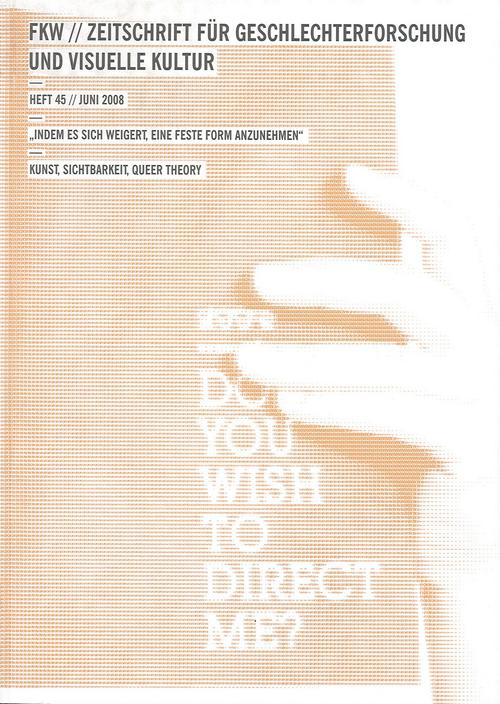No palm trees! Repräsentationen von Körpern ohne Körper
DOI:
https://doi.org/10.57871/fkw4520081110Abstract
No Palm Trees! Representations of Bodies without Bodies
What makes an artistic visual representation “queer”? My wider project is to develop methods and terms of a queer art theory, which involves desire and sexuality as a main focus. The considerations of “No Palm Trees” concentrate on an installation by the artist Felix Gonzalez Torres. His work represents bodies, but it refuses to explicitly show bodies that are supposed to visually demonstrate a deviation from the norm. My analysis of Gonzalez-Torres’ work instead introduces the terms “desire”, “fantasy”, and “queer spatial sex” (“queerer Raumsex”) – not as something being represented in the work, but as a “method” (Probyn 1996) between work, space, and spectators; a method of building and cutting connections (here towards “conceptual art”, “AIDS-politics”, “camp and queer aesthetics”), of creating and disrupting belongings. The analysis is thus built on the hypothesis that a disruption of dominant representations not only depends on a certain quality of an image or a text, but is in fact dependent on certain social constellations. Reference is made to Amy Robinson’s model of a “triangular theatre of identities” (Robinson 1994, see also Sieg 2002). Following this model, a group of spectators may produce a social constellation called an “in-group”, which is able to read practices as queer sexuality, while viewers that do not belong to this group may for example read the same practices – passing as conceptual art – only in relation to positions of art history. The thesis is that the “representations of bodies without bodies” represent the desire for different, plural, not clearly delimited subjectivities, outside the ideals of binary genders, heterosexuality, and being-American.
Downloads
Veröffentlicht
Ausgabe
Rubrik
Lizenz
Die Autor_innen behalten das Copyright und treten keine exklusiven Nutzungsrechte an FKW ab.
Ab 2017 erscheinen alle Texte von FKW // Zeitschrift für Geschlechterforschung und visuelle Kultur unter der LizenzCC-BY-NC-ND Lizenz 4.0 International (Creative Commons, Namensnennung, Nicht Kommerziell, Keine Bearbeitung 4.0 International). Der Lizenzvertrag ist abrufbar unter: https://creativecommons.org/licenses/by-nc-nd/4.0/legalcode.de, eine allgemein verständliche Fassung unter: https://creativecommons.org/licenses/by-nc-nd/4.0/deed.de
Von 2013 bis 2016 sind alle Texte von FKW // Zeitschrift für Geschlechterforschung und visuelle Kultur unter der Digital Peer Publishing Lizenz (DPPL) erschienen. Der Lizenztext ist im Internet abrufbar unter der Adresse: http://nbn-resolving.de/urn:nbn:de:0009-dppl-v2-de3
Die Abbildungen in Ihrem Beitrag
Die Autor_innen verpflichten sich, die Abdruckgenehmigung für die in ihren Texten verwendeten Bilder bei der jeweiligen, die Bildrechte verwaltenden Institution einzuholen und die zuständige Herausgeberin über das Ergebnis zu informieren. Wir weisen darauf hin, dass die Verwendung von Bildern in wissenschaftlichen Texten gewöhnlich als Zitat angesehen und entsprechend kostenfrei gewährt wird.





